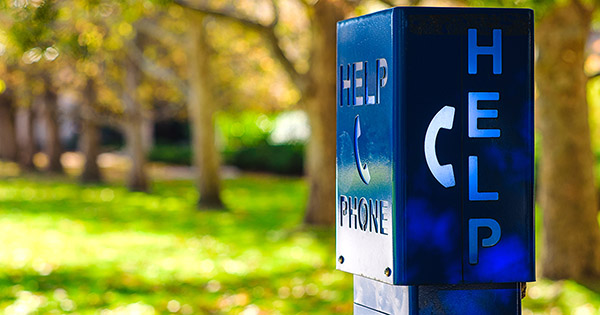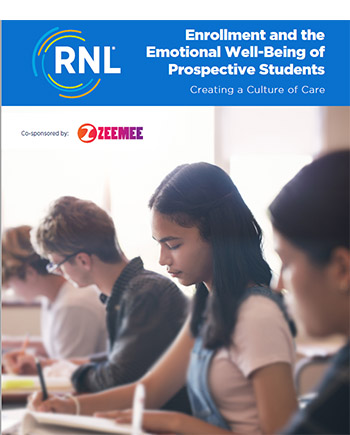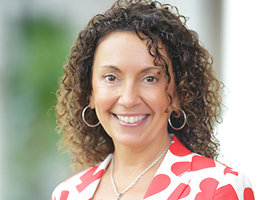enrollment
What Keeps Students Up at Night? Understanding College Safety Concerns

“I’m scared to walk alone at night.”
“What if someone targets me because I’m Muslim?”
“Will I be safe being openly gay on campus?”
These aren’t just random comments—they’re real voices from our latest research, and they stopped me cold.
For the past three years, RNL and ZeeMee have been diving deep into the emotional landscape of college planning. Our latest pulse survey (our third round!) reached over 2,600 high school seniors through the ZeeMee app, and their responses about safety concerns left me genuinely shaken.
Last year, we added a crucial question: we asked students who expressed worry about their safety in college to tell us, in their own words, what specifically scared them. Their candid responses paint a vivid— and sometimes heartbreaking—picture of what’s keeping our future college students up at night.
Here’s what they told us, unfiltered and unvarnished.
Understanding college safety concerns
Every night, a high school senior lies awake somewhere in America, staring at their college acceptance letter. But instead of dreaming about new friends and future possibilities, they’re wrestling with darker questions: “Will I be safe there? Will I belong? Will someone hurt me because of who I am?”
These aren’t just passing worries. They’re the heavy weight on students’ hearts as they contemplate their next big step. Through hundreds of candid conversations with students, we’ve uncovered the raw, unfiltered truth about what keeps them up at night. Their voices—brave, vulnerable, and achingly honest—paint a picture of what safety means to Generation Z and why traditional campus security measures are just the beginning of what they need to feel truly secure.
After analyzing hundreds of student comments about their safety concerns, 10 clear themes emerged, revealing how identity, background, and lived experience shape their fears. Understanding these concerns is crucial for colleges aiming to create safer, more supportive environments.
1. Personal safety and physical harm
Across all groups, students expressed anxiety about their physical safety on campus and in surrounding areas. Random attacks, mugging, and the general unpredictability of urban environments were frequent concerns.
- “I’m worried about approximate safety, like the area’s crime rate or state. There’s always going to be dangers.” – First-Generation Male
- “Being alone at night or generally in an open area with few people.” – First-Generation Female
Takeaway for institutions:
- Provide real-time crime alerts and transparent reporting about campus safety statistics.
- Partner with local authorities to increase security presence around campus.
- Encourage students to use campus safety apps for safe travel between locations.
2. Sexual assault and gender-based violence
Female and non-binary students, regardless of generation status, are consistently worried about sexual assault, harassment, and gender-based violence. Parties, walking alone at night, and navigating unfamiliar environments amplified these fears.
- “Rape culture is real. Parties can be dangerous, and not knowing who to trust makes it worse.” – Continuing-Generation Female
- “I’m suicidal and afraid of being raped.” – First-Generation Non-Binary
Takeaway for institutions:
- Expand bystander intervention training for all students.
- Ensure that Title IX resources and reporting processes are well-publicized and easily accessible.
- Provide self-defense classes and safe-ride programs for students traveling after dark.
3. Safety in new and urban environments
Moving to a new city or a high-crime area was a significant concern, particularly among first-generation students unfamiliar with city living.
- “The area of the college I chose is notoriously dangerous.” – Continuing-Generation Female
- “Since I’m out of state, I won’t know who to trust, especially in a big city.” – First-Generation Female
Takeaway for institutions:
- Offer city orientation programs to help students identify safe routes, neighborhoods, and resources.
- Highlight partnerships with local authorities and emergency services.
- Make campus safety maps available, showing emergency call boxes and security patrol zones.
4. Racial and ethnic discrimination
Concerns about racism, hate crimes, and bias were prominent among students of color, especially first-generation and male students. Black, Muslim, and international students frequently mentioned fears of being targeted because of their identity.
- “Since I’m African, racism and all that.” – First-Generation Male
- “I’m a Black Muslim woman. Being assaulted, being hate-crimed, Islamophobia.” – First-Generation Female
Takeaway for institutions:
- Create visible reporting channels for bias-related incidents.
- Provide diversity and inclusion training for campus staff and students.
- Ensure campus police and security are trained in cultural sensitivity.
5. Isolation and being alone
Being away from family and trusted support systems was a significant source of anxiety, especially for first-generation students. Women were more likely to express concerns about being alone while navigating new environments.
- “I would be alone away from home. Just knowing that anything could happen and I wouldn’t have that support system to call on.” – First-Generation Female
- “I’ve never lived away from home and don’t know if I’m ready to make safe decisions all the time.” – Continuing-Generation Male
Takeaway for institutions:
- Establish peer mentorship programs to help new students build connections.
- Promote campus counseling services, emphasizing their accessibility.
- Encourage students to join student organizations for community-building.
6. Campus safety and security measures
Many students, regardless of gender or generation status, questioned whether campus safety protocols were robust enough to protect them.
- “What if someone sneaks onto campus or tries to harm me?” – First-Generation Female
- “Sometimes the safety measures that are there aren’t enough.” – Continuing-Generation Male
Takeaway for institutions:
- Regularly assess and update campus security protocols.
- Provide students with clear information about emergency procedures.
- Ensure dormitories and common areas have secure access systems.
7. Substance use and peer pressure
Students were wary of the prevalence of drugs and alcohol on campus, especially in social settings where peer pressure could lead to unsafe situations.
- “Narcotics float around campus daily, causing self-harm to other students.” – Continuing-Generation Male
- “I’ve heard some college guys spike drinks, and it isn’t safe to go places alone.” – First-Generation Female
Takeaway for institutions:
- Promote alcohol and drug education programs during orientation and throughout the year.
- Partner with student organizations to create substance-free social events.
- Ensure campus safety staff are trained to handle substance-related emergencies.
8. Mental health and well-being
Many students expressed worries about managing their mental health while adjusting to college life, especially those from first-generation backgrounds.
- “I struggle with anxiety, and being in unpredictable places worries me.” – First-Generation Female
- “Just any fighting or being depressed.” – Continuing-Generation Male
Takeaway for institutions:
- Expand mental health resources, including counseling and peer support groups.
- Train faculty and staff to recognize signs of mental health struggles.
- Promote mindfulness and stress-relief programs on campus.
9. LGBTQ+ safety and acceptance
LGBTQ+ students are worried about harassment, discrimination, and feeling unsafe in gendered spaces.
- “I’m trans and nowhere really feels safe to be trans.” – First-Generation Non-Binary
- “I look like a cis male even though I am AFAB. I’m worried about my safety using the women’s bathroom.” – Continuing-Generation Non-Binary
Takeaway for institutions:
- Ensure that gender-neutral restrooms are available across campus.
- Promote LGBTQ+ resource centers and support groups.
- Train campus staff on LGBTQ+ inclusivity and safety.
10. Gun violence and mass shootings
With the rise in school shootings, concerns about gun violence were prevalent across all demographics.
- “The reality of increasing school shootings really scares me.” – First-Generation Female
- “How easily accessible and concealable guns are.” – Continuing-Generation Male
Takeaway for institutions:
- Conduct regular active shooter drills and safety trainings.
- Ensure campus police are equipped to handle potential threats.
- Promote anonymous reporting systems for suspicious activity.
Building safer campuses: Where do we go from here?
While each student’s experience is unique, the themes that emerge highlight common anxieties that colleges and universities must address. Institutions can make campuses feel safer by:
- Improving transparency: Regularly update students on campus safety protocols and crime statistics.
- Strengthening support systems: Expand counseling, mentorship, and peer support programs.
- Enhancing security: Invest in access-controlled dorms, safe-ride programs, and emergency call boxes.
- Promoting inclusivity: Ensure students from marginalized communities feel protected and respected.
- Empowering students: Provide self-defense classes, bystander training, and safety resources.
Behind every statistic in this report is a student’s story – a first-generation student wondering if they’ll make it home safely from their late-night library sessions, a transgender student searching for a bathroom where they won’t be harassed, a young woman calculating the safest route back to her dorm. Their fears are real, their concerns valid, and their hopes for a safe campus environment are deeply personal.
The path forward isn’t just about adding more security cameras or emergency phones, though those matter. It’s about creating spaces where every student can exhale fully, knowing they’re physically safe and emotionally secure. Where belonging isn’t just a buzzword in a campus brochure but a lived experience. Safety means being free to focus on learning, growing, and becoming—without constantly looking over your shoulder.
This isn’t just a challenge for institutions—it’s a sacred responsibility. Because when we promise students a college education, we promise them a chance to transform their lives. And that transformation can only happen when they feel truly safe being themselves. The students have spoken. They’ve shared their fears, hopes, and dreams for safer campuses. Now it’s our turn to listen—and, more importantly, to act.
Read Enrollment and the Emotional Well-Being of Prospective Students
RNL and ZeeMee surveyed 8,600 12th-grade students to understand their anxieties and worries of students during the college search process. Download your free copy to learn:
- The greatest challenges for 12th graders about the college planning process
- The barriers keeping students from applying to college
- The social fears of college that keep prospective students up at night
- The top safety concerns of students
- What excites and encourages students about the college journey
- How students describe these anxieties, stresses, and fears in their own words

